Compressive Behavior of Bamboo Sheet Twining Tube-Confined Concrete Columns
Abstract
:1. Introduction
2. Experimental Program
2.1. Specimen Design
2.2. Materials
2.2.1. Concrete
2.2.2. Bamboo Sheet
2.2.3. Epoxy Resin
2.3. Specimen Preparation
2.4. Test Setup and Instrumentation
3. Experimental Results
3.1. Failure Mode
3.2. Stress-Strain Relationship
3.3. Influence of the BCT Thickness
3.4. Dilation Behavior
4. Analysis
4.1. Lateral-to-Axial Strain Relationship
4.2. Evaluation of the Ultimate Strength
5. Conclusions
- (1)
- The failure mode of the BSTCC specimens is a serrated crack that initiates at the middle of the specimen, and then the crack propagates towards the two ends of the specimen along its longitudinal direction. The BCT provides strong lateral confinement, and the ability to bear axial loads as the BCT thickness increases, which limits the failure of the specimens and resists lateral expansion deformation.
- (2)
- The complete stress-strain curves can be divided into three stages for the BSTCC specimens under compression: the first linear elastic stage, the second nonlinear transition region, and the third nonlinear stage. Furthermore, the initial stiffness of the BSTCC specimens is independent of the BCT thickness.
- (3)
- Compared with the unconfined concrete, the effect of the BCT thickness on the ultimate stress and strain is significant. The compressive strength of the BSTCC specimens increases with increasing BCT thickness. However, the increase ratio of the ultimate stress does not always increase with an increase in the number of bamboo sheet layers; only when the layer number is in a certain range does the increase ratio of the ultimate stress increase as the number of bamboo sheet layers increases. In addition, when the strength of the concrete core is high, the confinement effect also decreases.
- (4)
- After evaluating the existing lateral-to-axial strain models, the results show that the model of Lim and Ozbakkaloglu has better performance. Based on the lateral-to-axial strain model proposed by Lim and Ozbakkaloglu, the authors modified the calculation formulas. The proposed model of the lateral-to-axial strain model shows good agreement with the experimental results.
- (5)
- The experimental results are compared with predictions of some existing FRP-confined concrete models. For the BSTCC specimens, the models proposed by Wu and Wei and Wei and Wu are superior to the other existing models because they are capable of predicting the ultimate stress with good accuracy and generality.
Author Contributions
Funding
Institutional Review Board Statement
Informed Consent Statement
Data Availability Statement
Conflicts of Interest
References
- Zhang, Y.R.; Wei, Y.; Bai, J.W.; Wu, G.; Dong, Z.Q. A novel seawater and sea sand concrete filled FRP-carbon steel composite tube column: Concept and behavior. Compos. Struct. 2020, 246, 112421. [Google Scholar] [CrossRef]
- Wei, Y.; Miao, K.T.; Zhang, X.; Zhou, Y.F.; Zheng, K.Q. Modeling for complete stress-strain curve of circular concrete columns confined with steel spiral and FRP. J. Build. Eng. 2021, 44, 1103294. [Google Scholar] [CrossRef]
- Wei, Y.; Cheng, X.Y.; Wu, G.; Duan, M.J.; Wang, L.B. Experimental investigations of concrete-filled steel tubular columns confined with high-strength steel wire. Adv. Struct. Eng. 2019, 22, 2771–2784. [Google Scholar] [CrossRef]
- Jiang, C.; Wu, Y.F. Axial strength of eccentrically loaded FRP-confined short concrete columns. Polymers 2020, 12, 1261. [Google Scholar] [CrossRef] [PubMed]
- Zhou, J.K.; Lin, G.; Teng, J.G. Stress-strain behavior of FRP-confined concrete containing recycled concrete lumps. Constr. Build. Mater. 2021, 267, 120915. [Google Scholar] [CrossRef]
- Wei, Y.; Bai, J.W.; Zhang, Y.R.; Miao, K.T.; Zheng, K.Q. Compressive performance of high-strength seawater and sea sand concrete-filled circular FRP-steel composite tube columns. Eng. Struct. 2021, 240, 112357. [Google Scholar] [CrossRef]
- Szostak, B.; Golewski, G.L. Improvement of strength parameters of cement matrix with the addition of siliceous fly ash by using nanometric C-S-H seeds. Energies 2020, 13, 6734. [Google Scholar] [CrossRef]
- Indra Reddy, M.; Anil Kumar, M.; Rama Bhadri Raju, C. Tensile and flexural properties of jute, pineapple leaf and glass fiber reinforced polymer matrix hybrid composites. Mater. Today Proc. 2018, 5, 458–462. [Google Scholar] [CrossRef]
- Chen, J.X.; Chouw, N. Flexural behaviour of flax FRP double tube confined coconut fibre reinforced concrete beams with interlocking interface. Compos. Struct. 2018, 192, 217–224. [Google Scholar] [CrossRef]
- Wang, B.; Bachtiar, E.V.; Yan, L.B.; Kasal, B.; Fiore, V. Flax, basalt, E-Glass FRP and their hybrid FRP strengthened wood beams: An experimental study. Polymers 2019, 11, 1255. [Google Scholar] [CrossRef] [Green Version]
- Hussain, Q.; Ruangrassamee, A.; Tangtermsirikul, S.; Joyklad, P. Behavior of concrete confined with epoxy bonded fiber ropes under axial load. Constr. Build. Mater. 2020, 263, 120093. [Google Scholar] [CrossRef]
- Yan, L.B.; Chouw, N. Natural FRP tube confined fibre reinforced concrete under pure axial compression: A comparison with glass/carbon FRP. Thin-Walled Struct. 2014, 82, 159–169. [Google Scholar] [CrossRef]
- Xia, Y.Y.; Xian, G.J.; Kafodya, I.; Li, H. Compression behavior of concrete cylinders externally confined by flax fiber reinforced polymer Sheets. Adv. Struct. Eng. 2014, 17, 1825–1834. [Google Scholar] [CrossRef] [Green Version]
- Sen, T.; Paul, A. Confining concrete with sisal and jute FRP as alternatives for CFRP and GFRP. Int. J. Sustain. Built Environ. 2015, 4, 248–264. [Google Scholar] [CrossRef] [Green Version]
- Nie, Y.H.; Wei, Y.; Huang, L.J.; Liu, Y.; Dong, F.H. Influence of slenderness ratio and sectional geometry on the axial compression behavior of original bamboo columns. J. Wood Sci. 2021, 67, 20. [Google Scholar] [CrossRef]
- Chen, S.; Wei, Y.; Peng, D.L.; Zhao, K.; Hu, Y.F. Experimental investigation of timber beams strengthened by bamboo scrimber with anchorage structure. Structures 2021, 33, 1–11. [Google Scholar] [CrossRef]
- Chen, G.; Wu, J.; Jiang, H.; Zhou, T.; Li, X.; Yu, Y.F. Evaluation of OSB webbed laminated bamboo lumber box-shaped joists with a circular web hole. J. Build. Eng. 2020, 29, 101129. [Google Scholar] [CrossRef]
- Wei, Y.; Wang, Z.Y.; Chen, S.; Zhao, K.; Zheng, K.Q. Structural behavior of prefabricated bamboo-lightweight concrete composite beams with perforated steel plate connectors. Arch. Civ. Mech. Eng. 2021, 21, 1–21. [Google Scholar] [CrossRef]
- Zhou, K.; Li, H.T.; Dauletbek, A.; Yang, D.; Xiong, Z.H.; Lorenzo, R.; Zhou, K.; Corbi, I.; Corbi, O. Slenderness ratio effect on the eccentric compression performance of chamfered laminated bamboo lumber columns. J. Renew. Mater. 2022, 10, 165–182. [Google Scholar] [CrossRef]
- Wang, Z.Y.; Wei, Y.; Hu, Y.F.; Chen, S.; Zhao, K. An investigation of the flexural performance of bamboo-concrete composite beams with precast light concrete slabs and dowel connectors. J. Build. Eng. 2021, 41, 102759. [Google Scholar] [CrossRef]
- Tian, L.M.; Kou, Y.F.; Hao, J. Axial compressive behaviour of sprayed composite mortar–original bamboo composite columns. Constr. Build. Mater. 2019, 215, 726–736. [Google Scholar] [CrossRef]
- Tian, L.M.; Kou, Y.F.; Hao, J. Flexural behavior of sprayed lightweight composite mortar-original bamboo composite beams: Experimental study. BioResources 2019, 14, 500–517. [Google Scholar]
- Wei, Y.; Chen, S.; Jiang, J.F.; Zhou, M.Q.; Zhao, K. Experimental investigation of bamboo-concrete composite beams with threaded reinforcement connections. J. Sandw. Struct. Mater. 2021. [Google Scholar] [CrossRef]
- Sun, X.F.; He, M.J.; Li, Z. Novel engineered wood and bamboo composites for structural applications: State-of-art of manufacturing technology and mechanical performance evaluation. Constr. Build. Mater. 2020, 249, 118751. [Google Scholar] [CrossRef]
- Wei, Y.; Tang, S.F.; Ji, X.W.; Zhao, K.; Li, G.F. Stress-strain behavior and model of bamboo scrimber under cyclic axial compression. Eng. Struct. 2020, 209, 110279. [Google Scholar] [CrossRef]
- Zhao, K.; Wei, Y.; Chen, S.; Hang, C.; Zhao, K. Experimental investigation of the long-term behavior of reconstituted bamboo beams with various loading levels. J. Build. Eng. 2021, 36, 102107. [Google Scholar] [CrossRef]
- Wei, Y.; Yan, S.C.; Zhao, K.; Dong, F.H.; Li, G.F. Experimental and theoretical investigation of steel-reinforced bamboo scrimber beams. Eng. Struct. 2020, 223, 111179. [Google Scholar] [CrossRef]
- Chiu, H.H.; Young, W.B. The longitudinal and transverse tensile properties of unidirectional and bidirectional bamboo fiber reinforced composites. Fibers Polym. 2020, 21, 2938–2948. [Google Scholar] [CrossRef]
- Sánchez, M.L.; Patiño, W.; Cárdenas, J. Physical-mechanical properties of bamboo fibers-reinforced biocomposites: Influence of surface treatment of fibers. J. Build. Eng. 2020, 28, 101058. [Google Scholar] [CrossRef]
- Chin, S.C.; Tee, K.F.; Tong, F.S.; Ong, H.R.; Gimbun, J. Thermal and mechanical properties of bamboo fiber reinforced composites. Mater. Today Commun. 2020, 23, 100876. [Google Scholar] [CrossRef]
- Javadian, A.; Smith, I.F.; Hebel, D.E. Application of sustainable bamboo-based composite reinforcement in structural-concrete beams: Design and evaluation. Materials 2020, 13, 696. [Google Scholar] [CrossRef] [Green Version]
- Kou, Y.F.; Tian, L.M.; Jin, B.B. Axial compressive behavior of bamboo slices twining tube-confined concrete. Eur. J. Wood Wood Prod. 2021, 1–15. [Google Scholar] [CrossRef]
- Lim, J.C.; Ozbakkaloglu, T. Lateral strain-to-axial strain relationship of confined concrete. J. Struct. Eng. 2015, 141, 168–173. [Google Scholar] [CrossRef]
- Jiang, T.; Teng, J.G. Analysis-oriented stress–strain models for FRP–confined concrete. Eng. Struct. 2007, 29, 2968–2986. [Google Scholar] [CrossRef] [Green Version]
- Chun, S.C.; Park, H.C. Load carrying capacity and ductility of RC columns confined by carbon fiber reinforced polymers. In Proceedings of the 3rd the International Conference on Composites in Infrastructure; The University of Arizona: San Francisco, CA, USA, 2002. [Google Scholar]
- Marques, S.P.C.; Marques, D.; da Silva, J.L.; Cavalcante, M.A.A. Model for analysis of short columns of concrete confined by fiber-reinforced polymer. J. Compos. Constr. 2004, 8, 332–340. [Google Scholar] [CrossRef]
- Lokuge, W.P.; Sanjayan, J.G.; Setunge, S. Stress-strain model for laterally confined concrete. J. Mater. Civ. Eng. 2005, 17, 607–616. [Google Scholar] [CrossRef]
- Richart, F.E. A Study of the Failure of Concrete under Combined Compressive Stresses; University of Illinois: Champaign, IL, USA, 1928. [Google Scholar]
- Samaan, M.; Mirmiran, A.; Shahawy, M. Model of concrete confined by fiber composites. J. Struct. Eng. 1998, 124, 1025–1031. [Google Scholar] [CrossRef]
- Lam, L.; Teng, J.G. Stress–strain model for FRP-confined concrete under cyclic axial compression. Eng. Struct. 2009, 31, 308–321. [Google Scholar] [CrossRef]
- Wu, G.; Lü, Z.T.; Wu, Z.S. Strength and ductility of concrete cylinders confined with FRP composites. Constr. Build. Mater. 2006, 20, 134–148. [Google Scholar] [CrossRef]
- Youssef, M.N.; Feng, M.Q.; Mosallam, A.S. Stress–strain model for concrete confined by FRP composites. Compos. Part B 2005, 38, 614–628. [Google Scholar] [CrossRef] [Green Version]
- Fahmy, M.F.M.; Zhishen, W.U. Evaluating and proposing models of circular concrete columns confined with different FRP composites. Compos. Part B 2010, 41, 199–213. [Google Scholar] [CrossRef]
- Wei, Y.Y.; Wu, Y.F. Unified stress–strain model of concrete for FRP-confined columns. Constr. Build. Mater. 2012, 26, 381–392. [Google Scholar] [CrossRef]
- Wu, Y.F.; Wei, Y. General stress-strain model for steel- and FRP-confined concrete. J. Compos. Constr. 2015, 19, 04014069. [Google Scholar] [CrossRef]

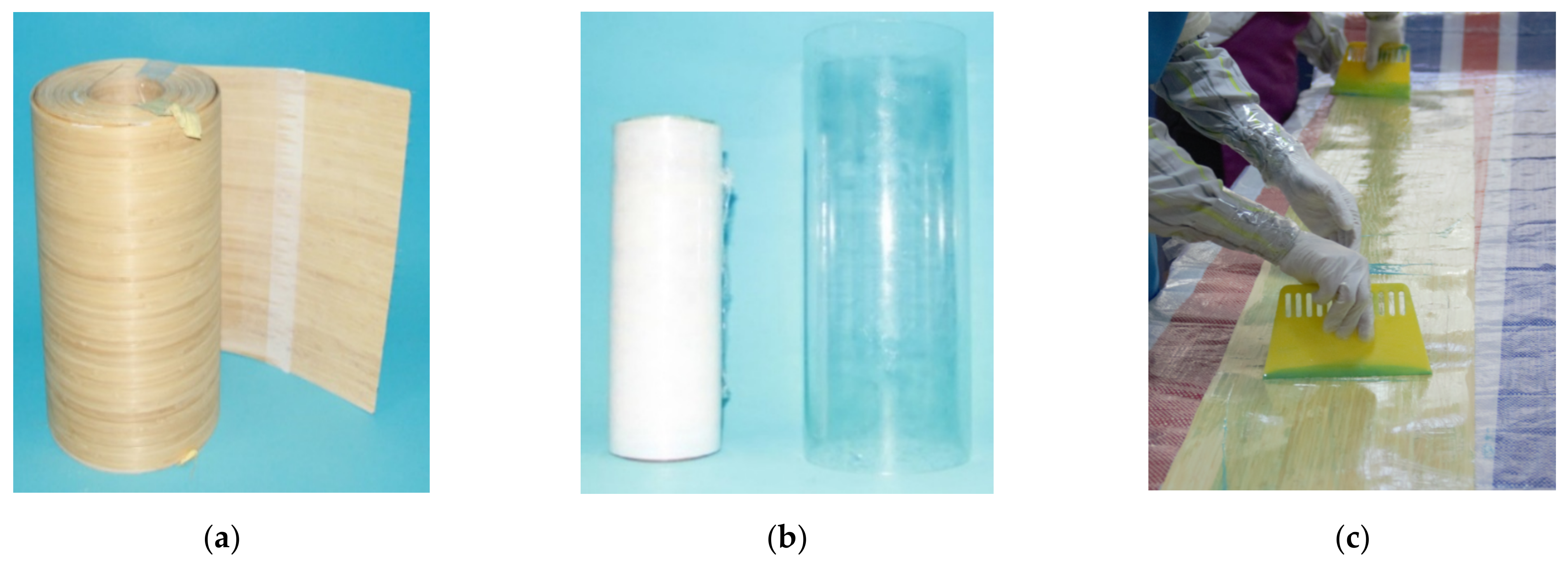
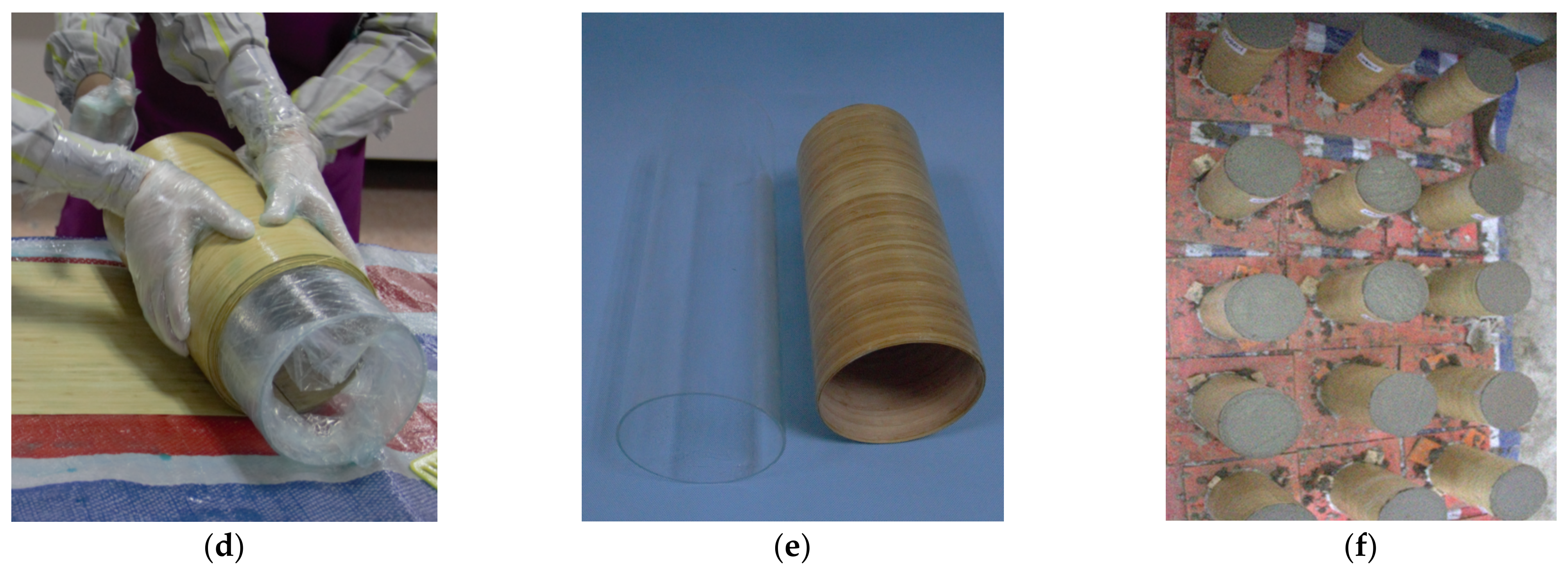


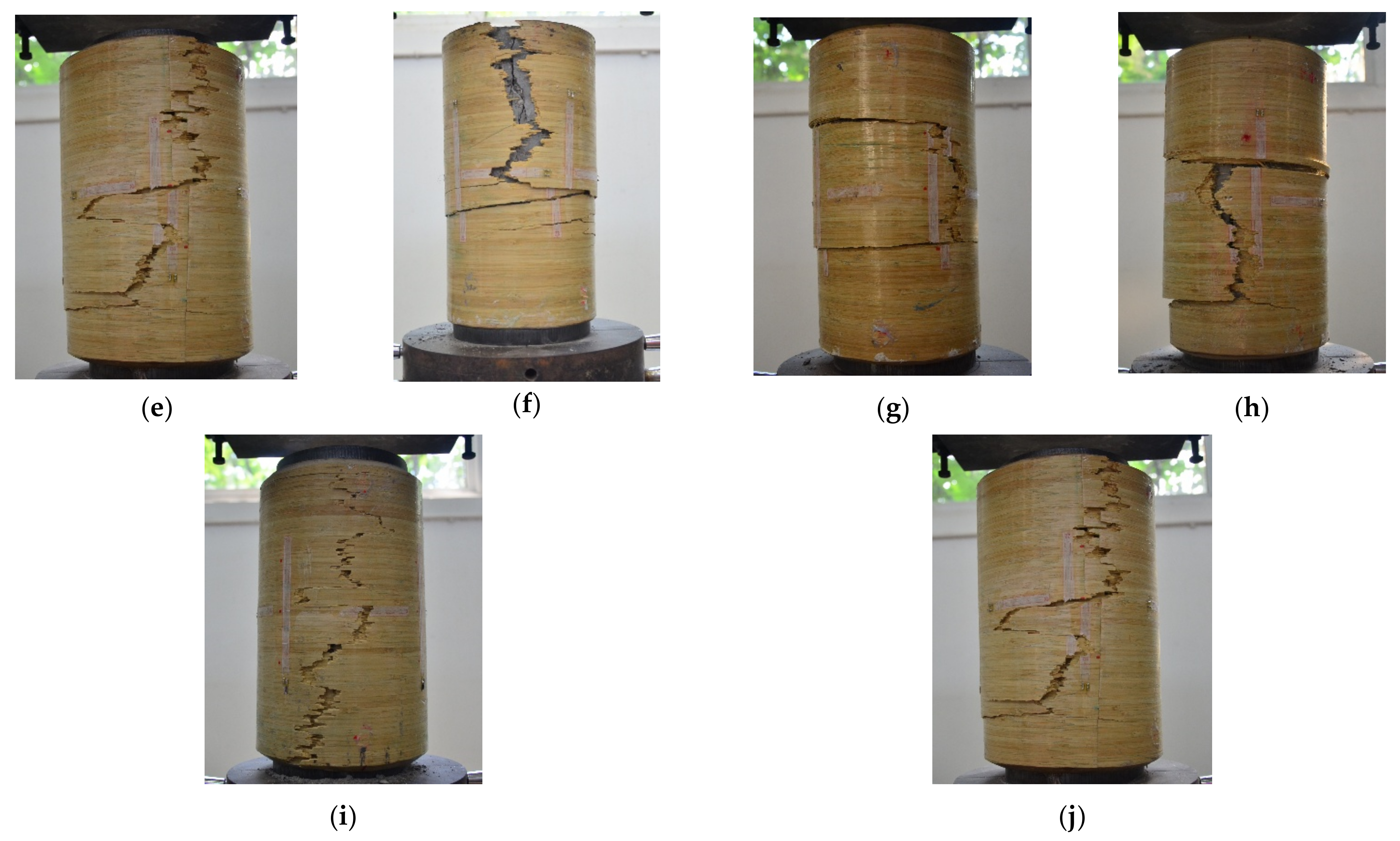
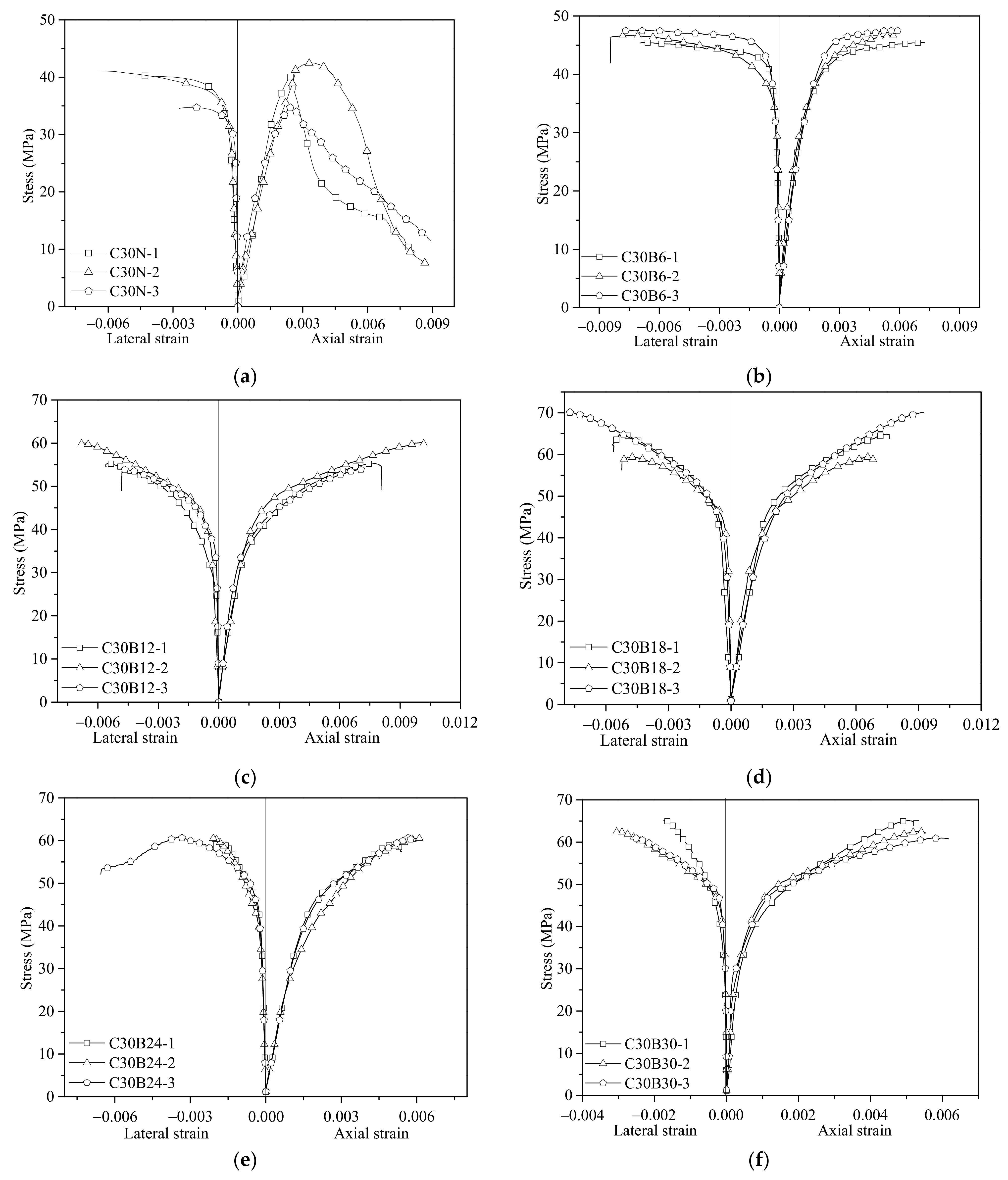



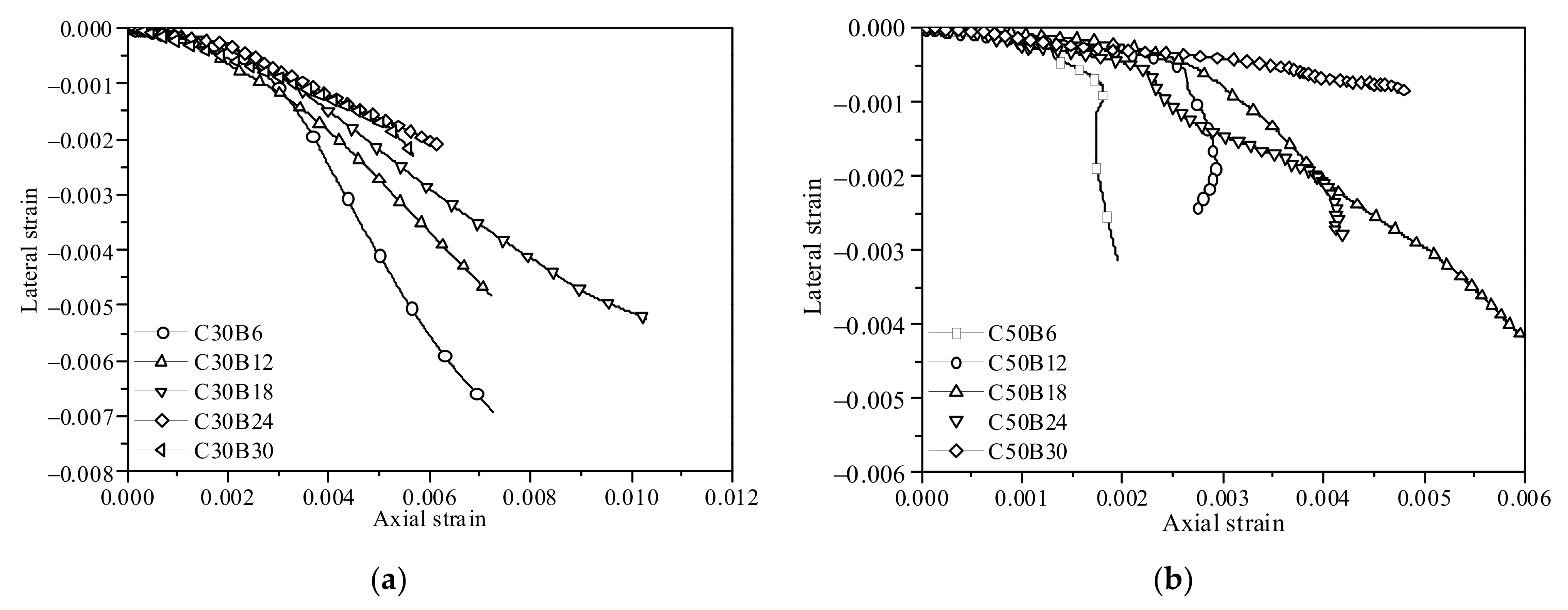
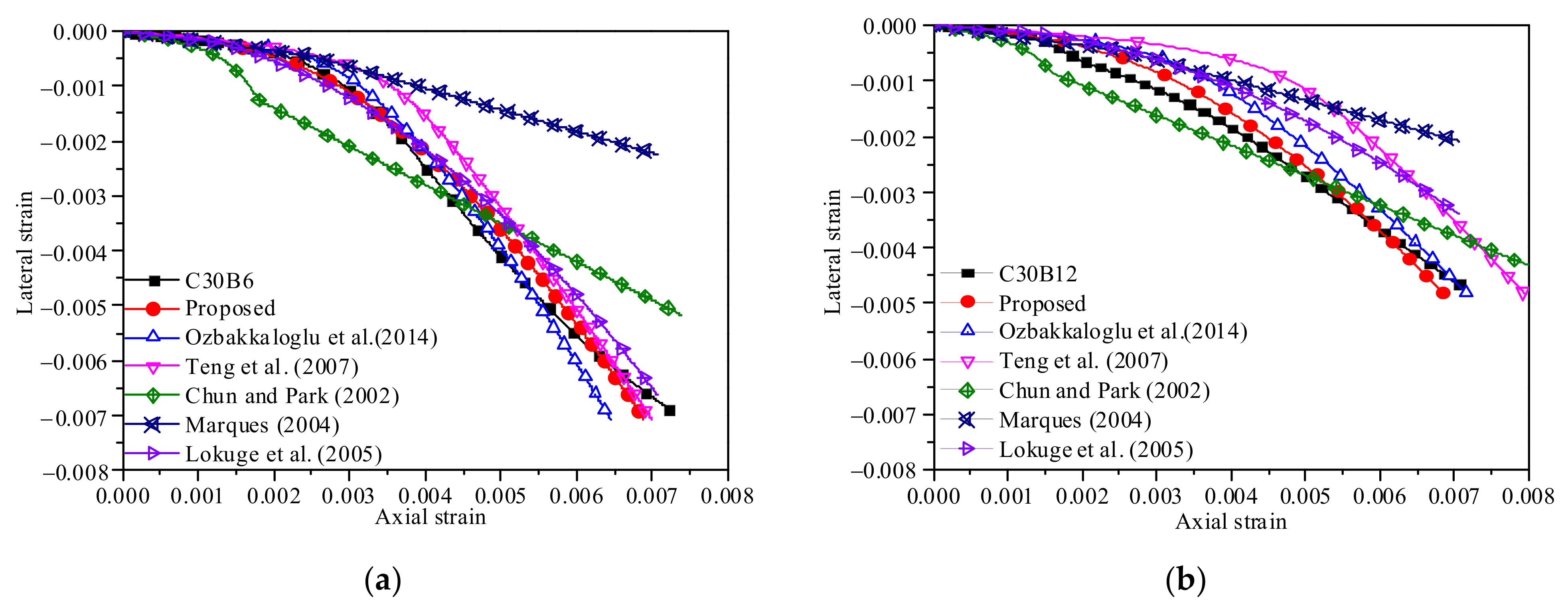
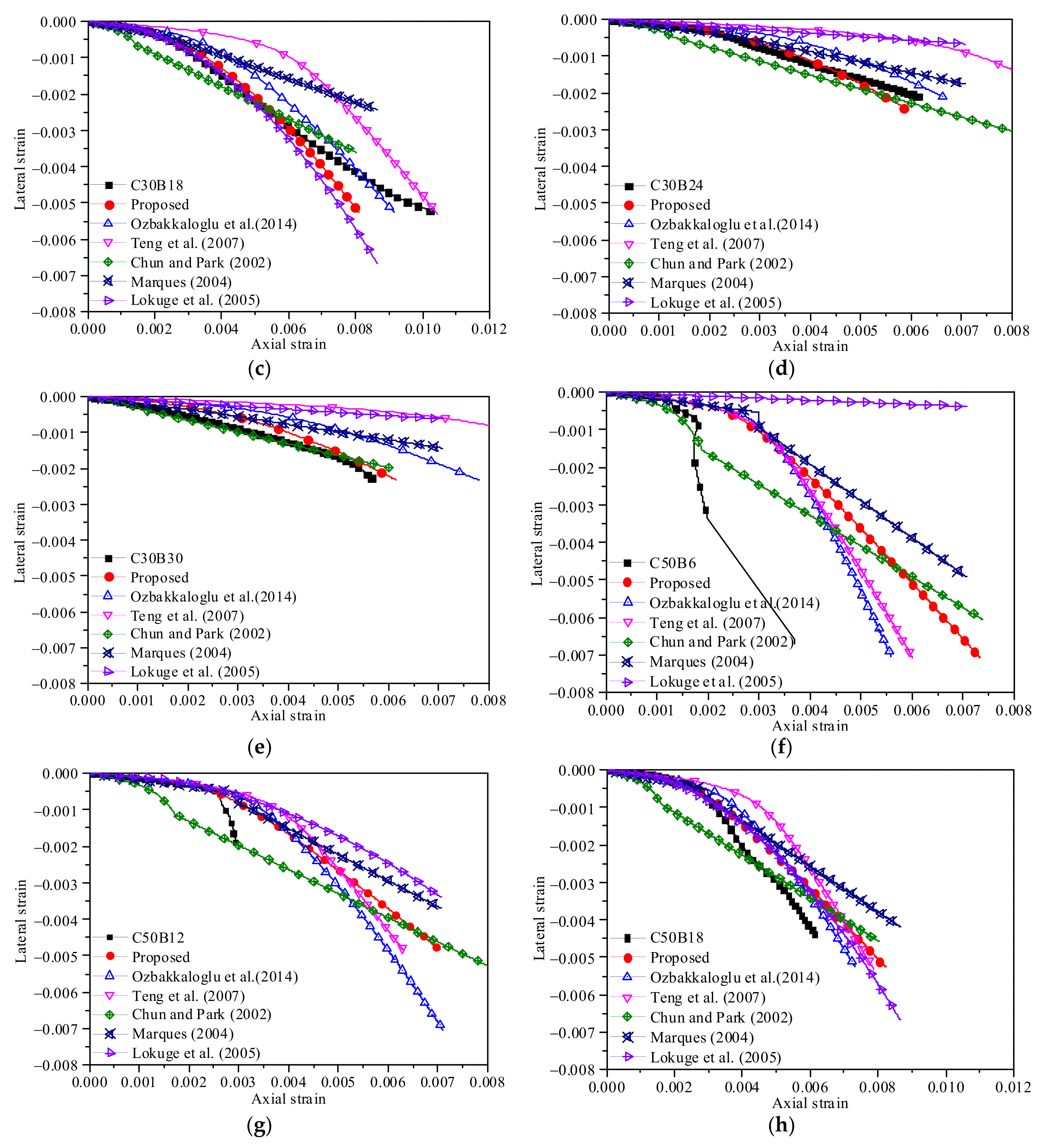
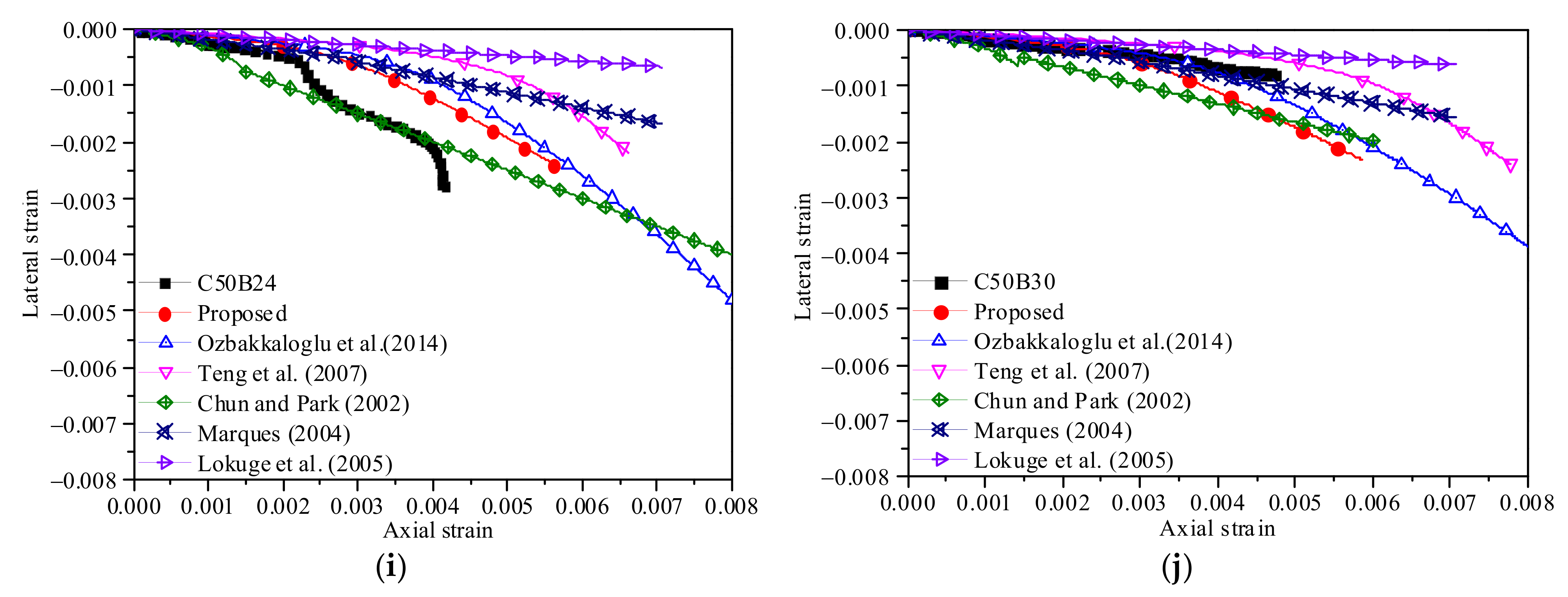
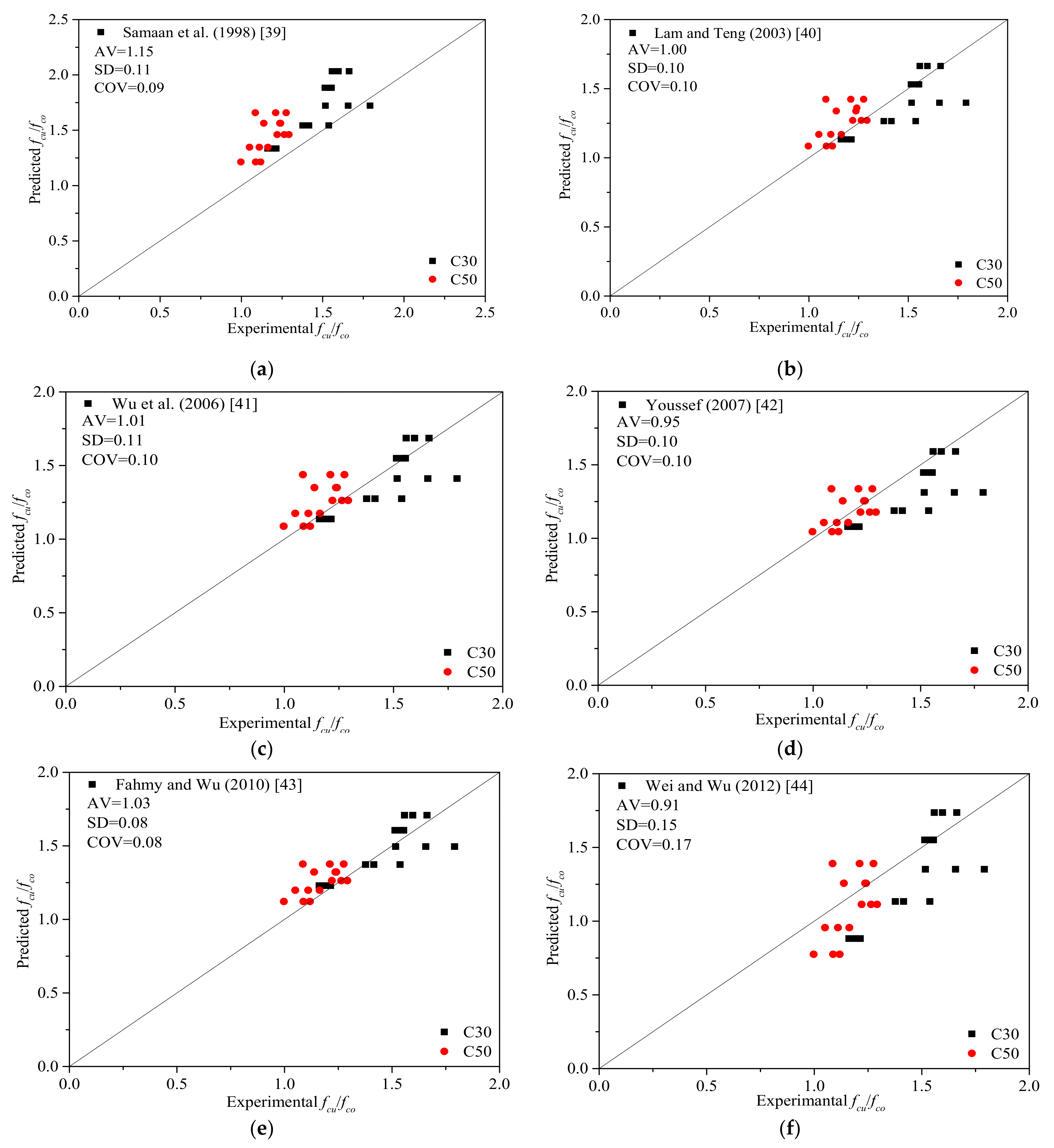

| No. | Specimen | Concrete Grade | Bamboo Sheet Layers | D (mm) | H (mm) | Number |
|---|---|---|---|---|---|---|
| 1 | C30N | C30 | 0 | 150 | 300 | 3 |
| 2 | C30B6 | C30 | 6 | 150 | 300 | 3 |
| 3 | C30B12 | C30 | 12 | 150 | 300 | 3 |
| 4 | C30B18 | C30 | 18 | 150 | 300 | 3 |
| 5 | C30B24 | C30 | 24 | 150 | 300 | 3 |
| 6 | C30B30 | C30 | 30 | 150 | 300 | 3 |
| 7 | C50N | C50 | 0 | 150 | 300 | 3 |
| 8 | C50B6 | C50 | 6 | 150 | 300 | 3 |
| 9 | C50B12 | C50 | 12 | 150 | 300 | 3 |
| 10 | C50B18 | C50 | 18 | 150 | 300 | 3 |
| 11 | C50B24 | C50 | 24 | 150 | 300 | 3 |
| 12 | C50B30 | C50 | 30 | 150 | 300 | 3 |
| Specimen | Compressive Strength (MPa) | Average (MPa) | Standard Deviation | Coefficient of Variation |
|---|---|---|---|---|
| C30-1 | 40.2 | 39.2 | 3.27 | 0.08 |
| C30-2 | 42.5 | |||
| C30-3 | 34.7 | |||
| C50-1 | 73.7 | 70.6 | 2.20 | 0.03 |
| C50-2 | 68.9 | |||
| C50-3 | 69.2 |
| Specimen | Bamboo Sheet | Pmax (kN) | fcc (MPa) | fco (MPa) | fcu (MPa) | εcc | εcu | ||
|---|---|---|---|---|---|---|---|---|---|
| nf | tf (mm) | fl (MPa) | |||||||
| C30N-1 | -- | -- | 0 | 711 | 40.24 | 39.15 | -- | 0.0025 | -- |
| C30N-2 | -- | -- | 0 | 750 | 42.48 | 39.15 | -- | 0.0035 | -- |
| C30N-3 | -- | -- | 0 | 613 | 34.72 | 39.15 | -- | 0.0020 | -- |
| C50N-1 | -- | -- | 0 | 1301 | 73.70 | 70.59 | -- | 0.0030 | -- |
| C50N-2 | -- | -- | 0 | 1216 | 68.87 | 70.59 | -- | 0.0031 | -- |
| C50N-3 | -- | -- | 0 | 1222 | 69.20 | 70.59 | -- | 0.0030 | -- |
| C30B6-1 | 6 | 3.0 | 2.69 | 803.2 | 39.62 | 39.15 | 45.48 | 0.0023 | 0.0071 |
| C30B6-2 | 6 | 3.0 | 2.69 | 824.7 | 39.29 | 39.15 | 46.7 | 0.002 | 0.0055 |
| C30B6-3 | 6 | 3.0 | 2.69 | 838.9 | 40.92 | 39.15 | 47.53 | 0.0024 | 0.0070 |
| C30B12-1 | 12 | 6.0 | 5.37 | 978.6 | 37.47 | 39.15 | 55.41 | 0.0017 | 0.0076 |
| C30B12-2 | 12 | 6.0 | 5.37 | 1062.9 | 40.20 | 39.15 | 60.19 | 0.0023 | 0.0100 |
| C30B12-3 | 12 | 6.0 | 5.37 | 952.3 | 37.95 | 39.15 | 53.92 | 0.0016 | 0.0070 |
| C30B18-1 | 18 | 9.0 | 8.06 | 1145.7 | 44.05 | 39.15 | 64.87 | 0.0026 | 0.0075 |
| C30B18-2 | 18 | 9.0 | 8.06 | 1048.5 | 41.08 | 39.15 | 59.39 | 0.0017 | 0.0067 |
| C30B18-3 | 18 | 9.0 | 8.06 | 1238.3 | 46.01 | 39.15 | 70.12 | 0.0025 | 0.0093 |
| C30B24-1 | 24 | 12.0 | 10.75 | 1146.8 | 46.72 | 39.15 | 59.27 | 0.0021 | 0.0051 |
| C30B24-2 | 24 | 12.0 | 10.75 | 1069.0 | 46.63 | 39.15 | 60.53 | 0.0025 | 0.0060 |
| C30B24-3 | 24 | 12.0 | 10.75 | 1074.6 | 47.95 | 39.15 | 60.85 | 0.0023 | 0.0057 |
| C30B30-1 | 30 | 15.0 | 13.44 | 1149.6 | 46.20 | 39.15 | 65.10 | 0.0013 | 0.0051 |
| C30B30-2 | 30 | 15.0 | 13.44 | 1104.1 | 49.71 | 39.15 | 62.51 | 0.0014 | 0.0053 |
| C30B30-3 | 30 | 15.0 | 13.44 | 1077.2 | 48.56 | 39.15 | 61.00 | 0.0014 | 0.0057 |
| C50B6-1 | 6 | 3.0 | 2.69 | 1215.0 | 68.03 | 70.59 | 68.80 | 0.0029 | 0.0042 |
| C50B6-2 | 6 | 3.0 | 2.69 | 1182.0 | 59.80 | 70.59 | 66.93 | 0.0021 | 0.0040 |
| C50B6-3 | 6 | 3.0 | 2.69 | 1083.1 | 57.83 | 70.59 | 61.33 | 0.0020 | 0.0026 |
| C50B12-1 | 12 | 6.0 | 5.37 | 1206.4 | 68.31 | 70.59 | 68.31 | 0.0018 | 0.0018 |
| C50B12-2 | 12 | 6.0 | 5.37 | 1263.4 | 71.54 | 70.59 | 71.54 | 0.0026 | 0.0021 |
| C50B12-3 | 12 | 6.0 | 5.37 | 1141.0 | 63.10 | 70.59 | 64.60 | 0.0019 | 0.0030 |
| C50B18-1 | 18 | 9.0 | 8.06 | 1325.7 | 72.26 | 70.59 | 75.06 | 0.0026 | 0.0035 |
| C50B18-2 | 18 | 9.0 | 8.06 | 1373.1 | 52.53 | 70.59 | 77.75 | 0.0016 | 0.0040 |
| C50B18-3 | 18 | 9.0 | 8.06 | 1404.0 | 74.87 | 70.59 | 79.50 | 0.0027 | 0.0036 |
| C50B24-1 | 24 | 12.0 | 10.75 | 1348.3 | 76.35 | 70.59 | 76.35 | 0.0017 | 0.0017 |
| C50B24-2 | 24 | 12.0 | 10.75 | 1343.5 | 76.07 | 70.59 | 76.07 | 0.0017 | 0.0017 |
| C50B24-3 | 24 | 12.0 | 10.75 | 1236.0 | 69.99 | 70.59 | 69.99 | 0.0017 | 0.0017 |
| C50B30-1 | 30 | 15.0 | 13.44 | 1107.3 | 66.77 | 70.59 | 66.77 | 0.0008 | 0.0008 |
| C50B30-2 | 30 | 15.0 | 13.44 | 1385.8 | 74.46 | 70.59 | 78.47 | 0.0015 | 0.0037 |
| C50B30-3 | 30 | 15.0 | 13.44 | 1315.6 | 74.49 | 70.59 | 74.49 | 0.0012 | 0.0012 |
| Models | Ultimate Strength |
|---|---|
| Samaan et al. (1998) [39] | |
| Lam and Teng (2003) [40] | |
| Wu et al. (2006) [41] | for strain-hardening for strain-softening |
| Youssef et al. (2007) [42] | |
| Fahmy and Wu (2010) [43] | |
| Wei and Wu (2012) [44] | |
| Wu and Wei (2014) [45] |
| Model | Average Value | Standard Deviation | Coefficient of Variation |
|---|---|---|---|
| Samaan et al. (1998) [39] | 1.15 | 0.11 | 0.09 |
| Lam and Teng (2003) [40] | 1.00 | 0.10 | 0.10 |
| Wu et al. (2006) [41] | 1.01 | 0.11 | 0.10 |
| Youssef et al. (2007) [42] | 0.95 | 0.10 | 0.10 |
| Fahmy and Wu (2010) [43] | 1.03 | 0.08 | 0.08 |
| Wei and Wu (2012) [44] | 0.91 | 0.15 | 0.17 |
| Wu and Wei (2014) [45] | 0.96 | 0.13 | 0.14 |
Publisher’s Note: MDPI stays neutral with regard to jurisdictional claims in published maps and institutional affiliations. |
© 2021 by the authors. Licensee MDPI, Basel, Switzerland. This article is an open access article distributed under the terms and conditions of the Creative Commons Attribution (CC BY) license (https://creativecommons.org/licenses/by/4.0/).
Share and Cite
Cheng, X.; Wei, Y.; Nie, Y.; Wang, G.; Li, G. Compressive Behavior of Bamboo Sheet Twining Tube-Confined Concrete Columns. Polymers 2021, 13, 4124. https://doi.org/10.3390/polym13234124
Cheng X, Wei Y, Nie Y, Wang G, Li G. Compressive Behavior of Bamboo Sheet Twining Tube-Confined Concrete Columns. Polymers. 2021; 13(23):4124. https://doi.org/10.3390/polym13234124
Chicago/Turabian StyleCheng, Xunyu, Yang Wei, Yuhan Nie, Gaofei Wang, and Guofen Li. 2021. "Compressive Behavior of Bamboo Sheet Twining Tube-Confined Concrete Columns" Polymers 13, no. 23: 4124. https://doi.org/10.3390/polym13234124
APA StyleCheng, X., Wei, Y., Nie, Y., Wang, G., & Li, G. (2021). Compressive Behavior of Bamboo Sheet Twining Tube-Confined Concrete Columns. Polymers, 13(23), 4124. https://doi.org/10.3390/polym13234124







